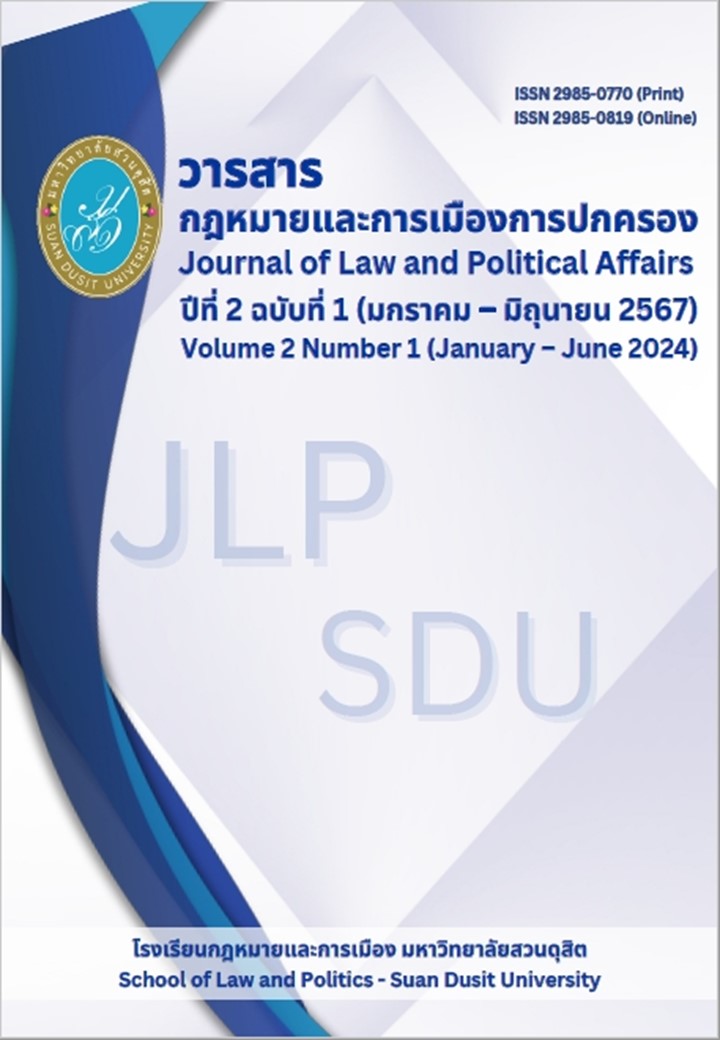กรณีศึกษา : ผลสำเร็จของการติดตามคนหายอาการอัลไซเมอร์
ดำรงศักดิ์ ขวนขวาย และไทรลดา นามมุงคุณ
คำสำคัญ:
คนหาย, คนหายอาการอัลไซเมอร์, การติดตามคนหายอาการอัลไซเมอร์บทคัดย่อ
บทความนี้มีวัตถุประสงค์เพื่อศึกษาผลสำเร็จของการติดตามคนหายอาการอัลไซเมอร์ของหน่วยงาน
ที่เกี่ยวข้องในการปฏิบัติภารกิจ ภายใต้อำนาจหน้าที่ของคณะอนุกรรมการบูรณาการภารกิจการติดตามคนหายพิสูจน์
คนนิรนามและศพนิรนาม ในการติดตามคนหายเป็นชายอายุ 92 ปี ที่หายออกจากบ้านด้วยอาการอัลไซเมอร์ในพื้นที่อำเภอเดิมบางนางบวช จังหวัดสุพรรณบุรี ด้วยกระบวนการติดตามคนหายและการตรวจพิสูจน์ทางนิติวิทยาศาสตร์ เริ่มต้นด้วยการรับแจ้งคนหายผ่านระบบฐานข้อมูลกลางในการจัดเก็บและสืบค้นข้อมูลคนหายและศพนิรนาม จากนั้นเข้าสู่กระบวนการตรวจพิสูจน์อัตลักษณ์บุคคลโดยใช้ข้อมูลภาพ ข้อมูลรูปพรรณสัณฐาน ข้อมูลอัตลักษณ์ และข้อมูลสารพันธุกรรมเป็นข้อมูลในการตรวจวิเคราะห์เปรียบเทียบข้อมูลคนหาย และการลงพื้นที่ไปยังสถานที่เกิดเหตุ
เพื่อติดตามคนหาย ค้นหาเบาะแสเพิ่มเติม และเก็บข้อมูลสารพันธุกรรมของญาติ โดยสายโลหิตของคนหาย รวมถึงได้มีการประชาสัมพันธ์ข้อมูลคนหายผ่านทุกช่องทาง ผลสำเร็จจากกระบวนการติดตามคนหายและการตรวจพิสูจน์ทางนิติวิทยาศาสตร์ ทำให้สามารถพบต้วคนหาย และตรวจเปรียบเทียบข้อมูลและยืนยันบุคคล ได้จากข้อมูลการแจ้งคนหาย
เอกสารอ้างอิง
กฤษณะ สุวรรณภูมิ. (2562). แผนภูมิครอบครัว (The family genogram). เข้าถึงเมื่อ 1 กันยายน 2566 จาก https://www.slideshare.net/georgesonthi/genogram-130087454
ระเบียบสำนักนายกรัฐมนตรี ว่าด้วยการติดตามคนหาย และการพิสูจน์คนนิรนามและศพนิรนาม พ.ศ. 2564. (2564). ราชกิจจานุเบกษา, 138(89ง)
ระบบฐานข้อมูลกลางในการจัดเก็บและสืบค้นข้อมูลบุคคลสูญหายและพิสูจน์ศพนิรนาม. (2566). สถิติคนหาย
คนนิรนาม และศพนิรนาม. เข้าถึงเมื่อ 1 กันยายน 2566 จาก https://www.thaimissing.go.th/
วีรศักดิ์ เมืองไพศาล. (2562). การป้องกัน การประเมินและการดูแลผู้ป่วยสมองเสื่อม (พิมพ์ครั้งที่ 5). สถานที่พิมพ์: บริษัท ภาพพิมพ์ จำกัด
ศูนย์ข้อมูลคนหาย มูลนิธิกระจกเงา. (2565). ริสแบนด์ และ ป้ายคิวอาร์โค้ด “หาย(ไม่)ห่วง”. เข้าถึงเมื่อ 4 กันยายน 2566 จาก https://wristband.thaimissing.org/home_m
ศูนย์ข้อมูลคนหาย มูลนิธิกระจกเงา. (2565). สถิติข้อมูลคนหายโรงคอัลไซเมอร์. เข้าถึงเมื่อ 4 กันยายน 2566
จาก http://www.backtohome.org/news_bth/inputdata/frm_search_data.php#showre
สุดสงวน สุธีสร. (2552). ความเป็นไปได้ในการจัดทำแผนที่อาชญากรรมในประเทศไทย. วารสารกระบวนการยุติธรรม, ปีที่ 2 (ฉบับที่ 1), 35-48
MacAndrew, M., Schnitker, L., Shepherd, N., & Beattie, E. (2018). People with dementia getting lost in Australia: Dementia related missing person reports in the media. Australasian journal on Ageing. 2018(Volume37), Issue3. E97-E103.
Rowe, M. A., Vandeveer,S.S., Greenblum, C. A,List,L. N., Fernandez,R. M., Mixson, N. E., & Ahn, H.C. (2011). Persons with dementia missing in the community: Is it wandering or something unique. BMC Geriatrics. 2011, 28(1).
ดาวน์โหลด
เผยแพร่แล้ว
รูปแบบการอ้างอิง
ฉบับ
ประเภทบทความ
สัญญาอนุญาต
ลิขสิทธิ์ (c) 2024 โรงเรียนกฎหมายและการเมือง มหาวิทยาลัยสวนดุสิต

อนุญาตภายใต้เงื่อนไข Creative Commons Attribution-NonCommercial-NoDerivatives 4.0 International License.
ลิขสิทธิ์ต้นฉบับที่ได้รับการตีพิมพ์ในวารสารกฎหมายและการเมืองการปกครอง ถือเป็นกรรมสิทธิ์ของโรงเรียนกฎหมายและการเมือง มหาวิทยาลัยสวนดุสิต ห้ามผู้ใดนำข้อความทั้งหมดหรือบางส่วนไปพิมพ์ซ้ำ เว้นแต่จะได้รับอนุญาตอย่างเป็นลายลักษณ์อักษรจากโรงเรียนกฎหมายและการเมือง มหาวิทยาลัยสวนดุสิต นอกจากนี้ เนื้อหาที่ปรากฎในบทความเป็นความรับผิดชอบของผู้เขียน ทั้งนี้ไม่รวมความผิดพลาดอันเกิดจากเทคนิคการพิมพ์







